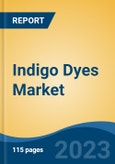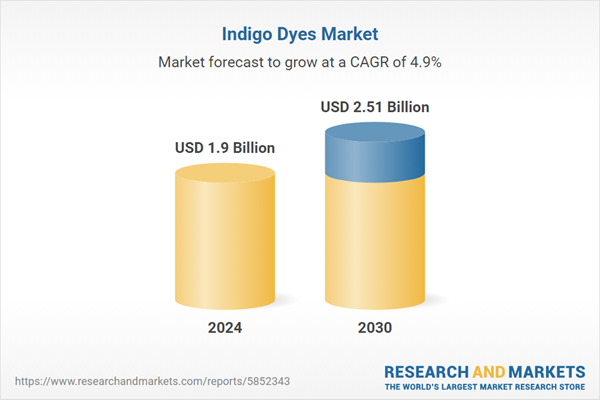Speak directly to the analyst to clarify any post sales queries you may have.
10% Free customizationThis report comes with 10% free customization, enabling you to add data that meets your specific business needs.
The global indigo dyes market is experiencing consistent growth, driven by their essential role in textile dyeing, particularly for denim, and expanding applications in fashion, cosmetics, and pharmaceuticals. Indigo dyes, derived from natural sources like plants or synthesized chemically, provide deep blue shades with excellent fastness properties, making them ideal for jeans, apparel, and home textiles. The market is propelled by the booming fashion industry, where denim remains a staple, and the shift toward sustainable dyeing processes amid environmental concerns. Government policies promoting eco-friendly textiles, such as those under the European Union’s Green Deal, encourage the use of natural indigo to reduce chemical pollution.
The rise of fast fashion and e-commerce has amplified demand, as brands seek cost-effective, high-quality dyes for large-scale production. Innovations in bio-based indigo, produced through fermentation, address sustainability issues, aligning with consumer preferences for organic products. The market also benefits from indigo's use in cosmetics for natural coloring and in pharmaceuticals for therapeutic applications. Challenges like synthetic alternatives persist, but the market is supported by the revival of natural indigo farming in regions like India.
Key Market Drivers
Rising Expanding Textile and Fashion Industries
The global indigo dyes market is significantly driven by the expanding textile and fashion industries, where indigo is essential for denim production and apparel dyeing. The fashion sector's growth is supported by rising consumer spending on clothing, with denim jeans alone accounting for a substantial portion of global apparel sales. Policies promoting textile exports, such as India's Textile Mission 2.0, encourage efficient dyeing processes, boosting indigo demand. Research indicates that the global denim market is projected to grow, with over 7 billion pairs of jeans sold annually, underscoring indigo's role in achieving desired shades and fastness.This trend is evident in Asia-Pacific, where countries like Bangladesh and Vietnam are major textile hubs, with export values increasing significantly in recent years. Manufacturers are investing in advanced dyeing technologies to meet fast fashion demands, with indigo providing cost-effective, durable coloring. Government incentives for sustainable textiles, such as subsidies for natural dyes in Europe, further drive adoption. The integration of indigo in premium brands, emphasizing eco-friendly practices, amplifies market momentum. This driver is expected to propel growth through 2030, as the textile industry prioritizes innovative, sustainable solutions to meet global fashion demands.
Key Market Challenges
High Production Costs for Natural Indigo
The indigo dyes market faces significant challenges due to high production costs for natural indigo, which requires labor-intensive farming and extraction processes. Limited scalability in regions like India, where indigo cultivation is traditional, increases expenses compared to synthetic alternatives. This issue is exacerbated by fluctuating agricultural yields, impacting supply consistency for textile manufacturers.The need for specialized processing facilities adds to costs, limiting adoption in price-sensitive markets like South America. Smaller producers struggle to compete with synthetic dyes, which are cheaper to produce. Addressing this challenge requires investments in modern farming techniques, but economic constraints hinder progress. The industry must overcome these cost barriers to ensure growth through 2030.
ey Market Trends
Revival of Natural Indigo in Sustainable Fashion
The trend towards sustainable manufacturing in the Indigo Dyes market is gaining momentum, with companies adopting green chemistry principles to reduce environmental footprints. This involves optimizing synthesis methods to minimize waste and energy use, supported by policies like the EU's Green Deal emphasizing circular economies.Facts from sustainability assessments highlight bio-based feedstocks and recycling techniques, enhancing product appeal in eco-conscious sectors. This trend fosters innovation in closed-loop systems, driving competitive advantages.
Key Market Players
- Guangzhou Diyi Dyeing Factory Co Ltd.
- DyStar L.P.
- Sam Vegetable Colours Pvt. Ltd.
- Hebei Hua-Chem Dye Chemical Co. Ltd
- Zhejiang Runtu Co. Ltd.
- Liyang Skyblue Chemical Co. Ltd
- Jiangsu Taifeng Chemical Co. Ltd.
- Kirpal Export Overseas
- Jacquard Fabrics, Inc.
- Jihua Group.
Report Scope:
In this report, global indigo dyes market has been segmented into following categories, in addition to the industry trends which have also been detailed below:Indigo Dyes Market, By Product Type:
- Synthetic Indigo Dye
- Nature Indigo Dye
Indigo Dyes Market, By Sales Channel:
- Direct
- Indirect
Indigo Dyes Market, By Application:
- Textiles
- Non-Textile
Indigo Dyes Market, By Region:
- North America
- United States
- Canada
- Mexico
- Europe
- Germany
- France
- United Kingdom
- Spain
- Italy
- Asia-Pacific
- China
- India
- South Korea
- Australia
- Japan
- South America
- Brazil
- Argentina
- Colombia
- Middle East & Africa
- South Africa
- Saudi Arabia
- UAE
Competitive Landscape
Company Profiles: Detailed analysis of the major companies present in global Indigo Dyes market.Available Customizations:
With the given market data, the publisher offers customizations according to a company’s specific needs. The following customization options are available for the report.Company Information
- Detailed analysis and profiling of additional market players (up to five).
This product will be delivered within 1-3 business days.
Table of Contents
Companies Mentioned
- Guangzhou Diyi Dyeing Factory Co Ltd.
- DyStar L.P.
- Sam Vegetable Colours Pvt. Ltd.
- Hebei Hua-Chem Dye Chemical Co. Ltd
- Zhejiang Runtu Co. Ltd.
- Liyang Skyblue Chemical Co. Ltd
- Jiangsu Taifeng Chemical Co. Ltd.
- Kirpal Export Overseas
- Jacquard Fabrics, Inc.
- Jihua Group.
Table Information
| Report Attribute | Details |
|---|---|
| No. of Pages | 186 |
| Published | September 2025 |
| Forecast Period | 2024 - 2030 |
| Estimated Market Value ( USD | $ 1.9 Billion |
| Forecasted Market Value ( USD | $ 2.51 Billion |
| Compound Annual Growth Rate | 4.9% |
| Regions Covered | Global |
| No. of Companies Mentioned | 10 |









